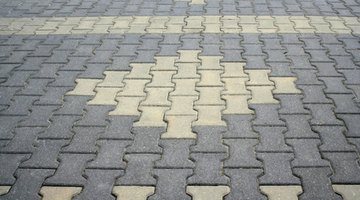How to Calculate the Number of Bricks Needed to Pave a Driveway
A well-designed brick driveway improves the curb appeal of your home and increases its value. To accurately estimate the cost of paving a brick driveway, you must calculate amount of materials needed for the project.

Tip
To allow for breakage and paving mistakes, buy at least 5 percent more bricks than you need.
The number of bricks you need to pave a driveway depends on the dimensions of the driveway, the size of the bricks and the spacing between the bricks. Knowing the number of bricks needed will help you set a construction budget.
-
Calculate the area of the driveway in square feet and call this number D. For rectangular driveways, D equals length times width (D = L_W). For trapezoidal driveways, D equals the height times the average of the length of the long and short sides. To get the average add the long and short side measurements and divide by two. The formula for the area of a trapezoid is D = H_(A+B)/2, where H is the height, A is the long side and B is the short side.
-
Measure the effective length of the brick by adding the length of an individual brick and the amount of spacing. For example, if the brick is 6 inches long and the spacing is 0.5 inches, then the effective length is 6.5 inches.
-
Measure the effective width of the brick by adding the width of an individual brick and the amount of spacing. For example, if the brick is 3 inches wide and the spacing is 0.5 inches, then the effective width is 3.5 inches.
-
Compute the effective area of the brick in square inches by multiplying the effective length and effective width. Divide this number by 144 to obtain the area in square feet, and call this number B.
-
Divide D by B to obtain the total number of bricks needed to pave the driveway.
-
Use this example as a guide when doing your own calculations: A driveway measures 12 feet by 15 feet and each brick is 6 inches by 3 inches with 0.5 inches of spacing between the bricks. Thus, D = 12_15 = 180 square feet and B = (6.5_3.5)/144 = 0.157986 square feet. The total number of bricks needed is 180/0.157986, which is approximately 1,140 bricks.
References
Writer Bio
Nucreisha Langdon has written professionally since 1991. She has ghostwritten more than 20 romantic fantasy novels, while her nonfiction work has appeared in the "Gainesville Sun" and the "Austin Chronicle." Langdon holds a Bachelor of Science in mathematics and a Bachelor of Arts in English from the University of Florida.
Photo Credits
- Close-up of an aged brick paved courtyard image by Piter Pkruger from Fotolia.com
- Close-up of an aged brick paved courtyard image by Piter Pkruger from Fotolia.com
More Articles



